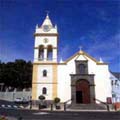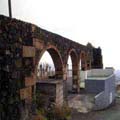History.
 These beautiful lands were occupied by the aborigines from before the conquest. The isle is named after an ancient guanche chief. This area was densely peopled by the guanches; various sepulchral and dwelling caves have been discovered in the canyons and amid the summits, as well as on the coast.
These beautiful lands were occupied by the aborigines from before the conquest. The isle is named after an ancient guanche chief. This area was densely peopled by the guanches; various sepulchral and dwelling caves have been discovered in the canyons and amid the summits, as well as on the coast.
The origin of the settlement of the Villa of Arafo is thought to have been brought about to take advantage of the lumber resources. This nucleus, unlike other municipalities of the isle, concentrates most of the population. Colonial settlements are scattered over all the district, although there was no rapid growth due to the long distance from the coast, so its survival has largely been based upon agriculture.
 In 1705 Arafo’s volcano erupted, in 1813 it became a municipality, and was bestowed with the title of Villa in May of 1983, becoming the first town to receive this honour from the Presidency of the Canary Government.
In 1705 Arafo’s volcano erupted, in 1813 it became a municipality, and was bestowed with the title of Villa in May of 1983, becoming the first town to receive this honour from the Presidency of the Canary Government.
Places of Historical Interest
Chapel of the Cross (Capilla de la Cruz). (El Aserradero)
Chapel of the Pine Master (Capilla del Señor del Pino)
Probably since the XVIII century, there are three wooden crosses located at the base of an ancient pine from before the conquest, that gave the place its name, known as "El Calvario".
The origin of the chapel dates back to the second half of the XIX century, when a town dweller deposited an image of the Crucifix that he had casually brought with him, at the foot of a centennial pine tree. It was decided then to construct a temple there, that with the passing of time has become the most cherished symbol of this southern municipality.
Church of San Juan Degollado.
Towards the end of the XVIII century, a primitive temple was constructed, and after several enlargements it became the present day church.
In 1738 the transactions to acquire the category of church commenced, and the temple was enriched with decorations and donations, while a second part was built. The third and last enlargement was carried out right after the church’s foundation and consisted of the construction of the present day presbytery and sacristy. The façade of grey quarry stone is also from the XVIII century. In 1924, a tower was built, financed by a commission of neighbours and in 1975 a new chapel was opened in the hall, in which Saint Christ of the Valley (Santísimo Cristo del Valle) was placed.
Among the images those of San Juan Degollado stand out, also notable are those of Saint Bernardo and Saint Agustín, all from the beginning of the XVIII century. The one of Saint Christ of the Valley (Cristo del Valle), came from Garachico in 1860, and the one of Auxiliary Mary Honorary Mayor of the Villa of Arafo, was brought to town in 1907.
The farm ( La granja).
Ancient Dominican settlement from the XVII century.